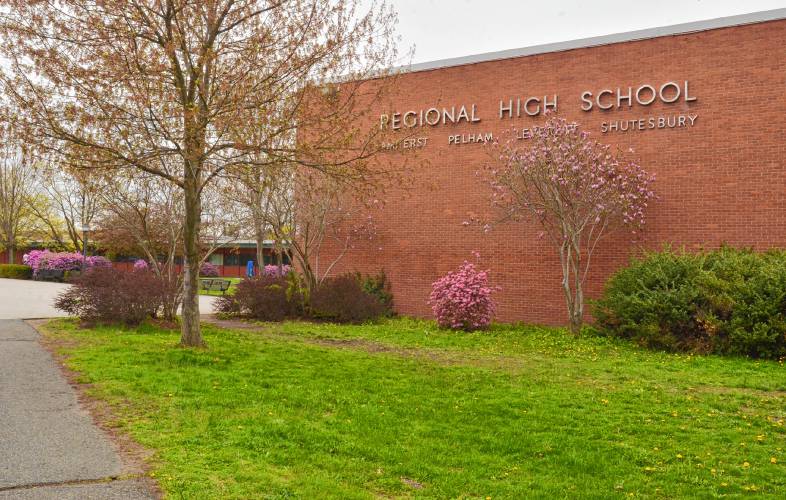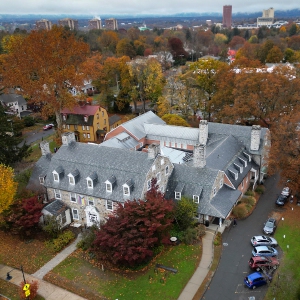Amherst-Pelham schools to make plea to town of Amherst for help closing $1.9M budget gap

Amherst Regional High School.
| Published: 02-03-2024 11:00 AM |
AMHERST — To stave off a portion of what could be nearly $1.9 million in reductions and efficiencies to balance next year’s Amherst-Pelham Regional Schools budget, Amherst representatives to the Regional School Committee intend to seek more financial support from the town of Amherst.
With a formal budget presentation at Tuesday’s regional committee meeting confirming preliminary numbers presented at a Four Town Meeting of Amherst, Pelham, Shutesbury and Leverett officials in December, showing that the budget will fall almost $2 million short of the $36.5 million needed to maintain current services, calls are being made to ask the Amherst Town Council and its Finance Committee to scrap a recommended cap on the increase in Amherst’s regional school assessment of 3%.
Amherst representative Irv Rhodes said an appeal for a higher assessment for Amherst could be made, though he doubted its likely success, based on what the schools have experienced in previous years. In 2023, the regional committee asked for an additional $84,000 from Amherst, which was denied.
“We know how that went last year, and I expect the same result,” Rhodes said. “However it certainly should be argued that we have more. Definitely, if you don’t ask for something, you can’t get anything.”
The push for having Amherst provide a higher assessment came from Leverett representative Tilman Wolf, who encouraged his colleagues who serve on the Budget Coordinating Group, made up of members of the Amherst Town Council, Amherst School Committee and Jones Library trustees, to allow for a 4% increase in Amherst’s assessment, which would provide $177,000 more money for the regional schools.
Wolf said Leverett officials want the district to develop a level services budget and apply a maximum of 4% increase for each towns’ assessment, rather than allowing Amherst to set its assessment at a 3% increase, and then for the smaller towns to follow, based on the statutory formula used to calculate assessments.
“The whole point of the statutory method is that we can all use the same process,” Wolf said,
“I don’t think it’s right that a town can say it wants a lower percentage, and impact the services that are provided for everyone,” Wolf said, referring to Amherst’s recommended limit.
Article continues after...
Yesterday's Most Read Articles
 Granby Bow and Gun Club says stray bullets that hit homes in Belchertown did not come from its range
Granby Bow and Gun Club says stray bullets that hit homes in Belchertown did not come from its range
 Super defers Amherst middle school principal pick to successor; one finalist says decision is retaliation for lawsuit
Super defers Amherst middle school principal pick to successor; one finalist says decision is retaliation for lawsuit
 ‘Home away from home’: North Amherst Library officially dedicated, as anonymous donor of $1.7M revealed
‘Home away from home’: North Amherst Library officially dedicated, as anonymous donor of $1.7M revealed
 Political newcomer defeats Shores Ness for Deerfield Selectboard seat
Political newcomer defeats Shores Ness for Deerfield Selectboard seat
 A DIY approach to flying: Local pilots build and help build their own aircraft
A DIY approach to flying: Local pilots build and help build their own aircraft
 Back to the screen: Amherst authors’ popular ‘Spiderwick Chronicles’ gets a new streaming adaptation
Back to the screen: Amherst authors’ popular ‘Spiderwick Chronicles’ gets a new streaming adaptation
Interim Superintendent Doug Slaughter said such a message to the Budget Coordinating Group that it wants a 4% assessment from Amherst can be made, though he cautioned that for Amherst to meet that number, discussions would have to happen about slicing the pie differently for other services in town, such as public safety and public works.
“What it’s going to require to meet this number will be other departments in the town at a lower percentage,” Slaughter said.
Still, Amherst representatives appeared poised to encourage the discussion at the Budget Coordinating Group.
“Right now these numbers are really dire,” said Amherst representative Bridget Hynes. “That’s a significant amount of cuts.”
Hynes said she hopes Slaughter and Shannon Bernacchia, the interim finance chief for the schools, could also provide a budget model with fewer cuts, but associated higher assessments for all four towns.
To maintain level services, Bernacchia explained that the budget needs to go up $2.79 million, or 8.3%, from this year’s $33.7 million spending plan. In addition to various state aid and reimbursements that cover portions of the budget, the remainder of such an increase would have to come through assessments from each of the four member towns, with votes on those assessments coming at annual Town Meetings and by the Amherst Town Council.
Using Amherst’s 3% limit, those assessments, using the statutory assessment method set by the state, would bring in $22.66 million, a $785,692, or 3.59%, increase, over the $21.88 million in assessments to support this year’s budget. But the 3% limit set by Amherst, supplemented by a so-called guardrail system in which none of the smaller towns can see assessments rise by more than 4% — with Pelham and Leverett otherwise going over this increase based on the statutory formula — means the assessments can only go up by $656,481, costing the regional schools an additional $129,211.
Should Amherst go up to 4%, though, that would add around $177,000 back in to support the budget.
Bernacchia said there is also hope that cuts may be limited by use of more federal Elementary and Secondary School Emergency Relief funds.
“Depending on what the special education reimbursement is, we might be able to carry over some more ESSER funds into FY25 to help reduce this (deficit),” Bernacchia said.
Still, challenges remain. “It’s going to be really difficult,” Bernacchia said.
The 8.3% increase in overall spending comes from special education needs remaining high after the pandemic, significant salary boosts from settled contracts, health insurance and school liability increases, and various facility costs, such as trash removal.
“There has been inflation across the board within all of our categories,” Bernacchia said.
Only the vocational, charter and school choice accounts are holding steady.

 Sharing a few notes: High schoolers coaching younger string players one on one
Sharing a few notes: High schoolers coaching younger string players one on one Reyes takes helm of UMass flagship amid pro-Palestinian protests
Reyes takes helm of UMass flagship amid pro-Palestinian protests Sole over-budget bid could doom Jones Library expansion project
Sole over-budget bid could doom Jones Library expansion project Amherst poised to hire police department veteran as new chief
Amherst poised to hire police department veteran as new chief 